The Intel Optane Memory (SSD) Preview: 32GB of Kaby Lake Caching
by Billy Tallis on April 24, 2017 12:00 PM EST- Posted in
- SSDs
- Storage
- Intel
- PCIe SSD
- SSD Caching
- M.2
- NVMe
- 3D XPoint
- Optane
- Optane Memory
BAPCo SYSmark 2014 SE
BAPCo's SYSmark 2014 SE is an application-based benchmark that uses real-world applications to replay usage patterns of business users in the areas of office productivity, media creation and data/financial analysis. In addition, it also addresses the responsiveness aspect which deals with user experience as related to application and file launches, multi-tasking etc. Scores are meant to be compared against a reference desktop (the SYSmark 2014 SE calibration system in the graphs below). While the SYSmark 2014 benchmark used a Haswell-based desktop configuration, the SYSmark 2014 SE makes the move to a Lenovo ThinkCenter M800 (Intel Core i3-6100, 4GB RAM and a 256GB SATA SSD). The calibration system scores 1000 in each of the scenarios. A score of, say, 2000, would imply that the system under test is twice as fast as the reference system.
SYSmark scores are based on total application response time as seen by the user, including not only storage latency but time spent by the processor. This means there's a limit to how much a storage improvement could possibly increase scores. It also means our Optane review system starts out with an advantage over the SYSmark calibration system due to the faster processor and more RAM.



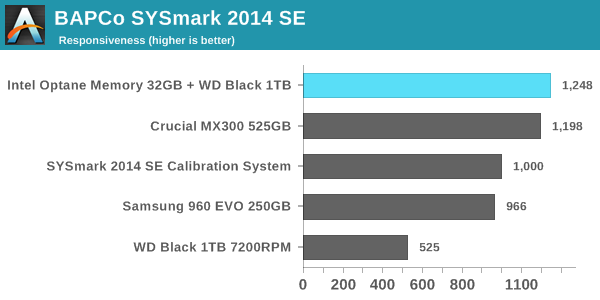
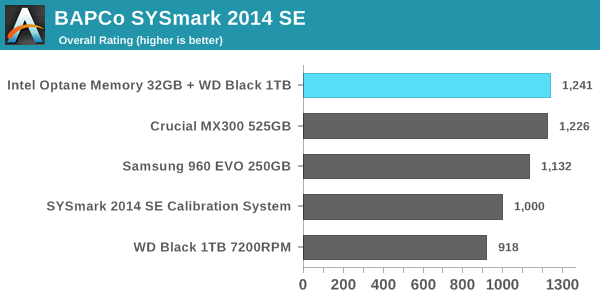
In every performance category the Optane caching setup is either in first place or a close tie for first. The Crucial MX300 is tied with the Optane configuration for every sub-test except the responsiveness test, where it falls slightly behind. The Samsung 960 EVO 250GB struggles, partly because its low capacity and the low degree of parallelism that implies means it often cannot take advantage of the performance offered by its PCIe 3.0 x4 interface. The use of Microsoft's built-in NVMe driver instead of Samsung's may also be holding it back. As expected, the WD Black hard drive scores substantially worse than our solid-state configurations on every test, with the biggest disparity occurring in the responsiveness test: The WD Black hard drive will force users to spend more than twice as much time waiting on their computer than if it has a SSD.
Energy Usage
SYSmark 2014 SE also adds energy measurement to the mix. A high score in the SYSmark benchmarks might be nice to have, but, potential customers also need to determine the balance between power consumption and the efficiency of the system. For example, in the average office scenario, it might not be worth purchasing a noisy and power-hungry PC just because it ends up with a 2000 score in the SYSmark 2014 SE benchmarks. In order to provide a balanced perspective, SYSmark 2014 SE also allows vendors and decision makers to track the energy consumption during each workload. In the graphs below, we find the total energy consumed by the PC under test for a single iteration of each SYSmark 2014 SE workload and how it compares against the calibration systems.
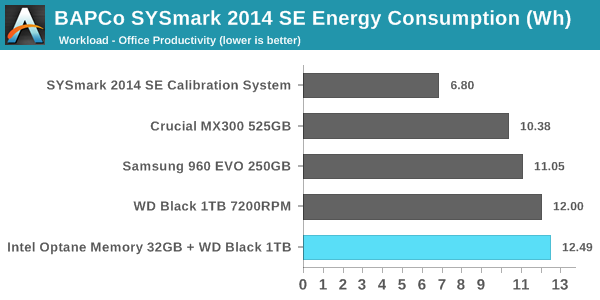
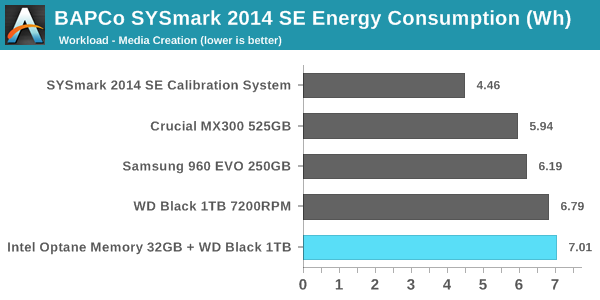
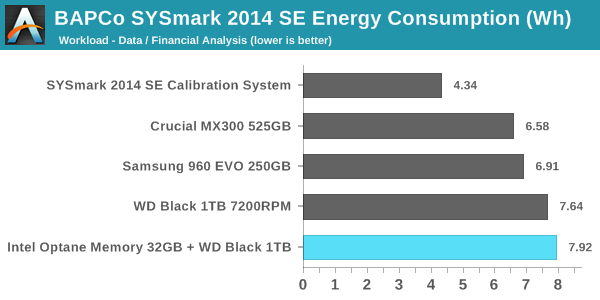
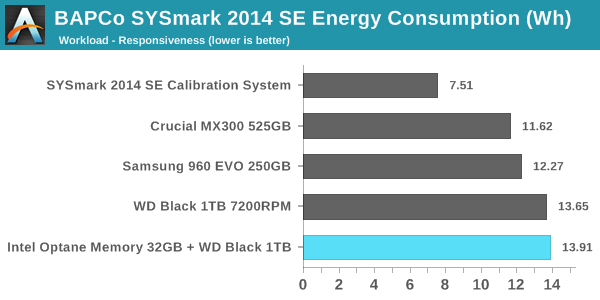
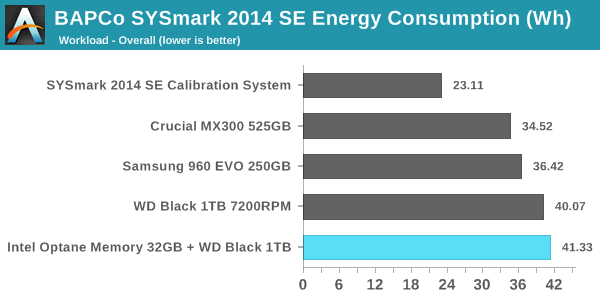
The peak power consumption of a PCIe SSD under load can exceed the power draw of a hard drive, but over the course of a fixed workload hard drives will always be less power efficient. SSDs almost always complete the data transfer sooner, and they can enter and leave their low-power idle states far quicker. On a benchmark like SYSmark, there are no idle times long enough for a hard drive to spin down and save power.
With an idle power of 1W, the Optane cache module substantially increases the already high power consumption of the hard drive-based configurations. It does allow for the tests to complete sooner, but since the Optane module does nothing to accelerate the compute-bound portions of SYSmark, the total time saved is not enough to make up the difference. It also appears that the Optane caching is not being used to enable more aggressive power saving on the hard drive—Intel's probably flushing writes from the cache often enough to keep the hard drive spinning the whole time. What this adds up to is a difference that's quite clear but not big enough for desktop users to be too concerned with unless their electricity prices are high. The Optane Memory caching configuration is the most power-hungry option we tested, while the second-place performing Crucial MX300 configuration was most efficient, using about 16% less energy overall.
For mobile users, the power consumption of the Optane plus hard drive configuration is pretty much a deal-breaker. Our Optane review system is not optimized for power consumption the way a notebook system would be, so for a mobile user the Optane module would account for an even larger portion of the total battery draw, and battery life will take a serious hit.










110 Comments
View All Comments
name99 - Tuesday, April 25, 2017 - link
Why are you so sure you understand the technology? Intel has told us nothing about how it works.What we have are
- a bunch of promises from Intel that are DRAMATICALLY not met
- an exceptionally lousy (expensive, low capacity) product being sold.
You can interpret these in many ways, but the interpretation that "Intel over promised and dramatically underdelivered" is certainly every bit as legit as the interpretation "just wait, the next version (which ships when?) will be super-awesome".
If Optane is capable TODAY of density comparable to NAND, then why ship such a lousy capacity? And if it's not capable, then what makes you so sure that it can reach NAND density? Getting 3D-NAND to work was not a cheap exercise. Does Intel have the stomach (and the project management skills) to last till that point, especially given that the PoS that they're shipping today ain't gonna generate enough of a revenue stream to pay for the electric bill of the Optane team while they take however long they need to get out the next generation.
emn13 - Tuesday, April 25, 2017 - link
Intel hasn't confirmed what it is, but AFAICT all the signs point to xpoint being phase-change ram, or at least very similar to it. Which still leaves a lot of wiggle room, of course.ddriver - Tuesday, April 25, 2017 - link
IIRC they have explicitly denied xpoint being PCM. But then again, who would ever trust a corporate entity, and why?Cellar - Tuesday, April 25, 2017 - link
Implying Intel would only use only the revenue of Optane to fund their next generation of Optane. You forget how much profit they make milking out their Processors? *Insert Woody Harrelson wiping tears away with money gif*name99 - Tuesday, April 25, 2017 - link
Be careful. What he's criticizing is the HYPE (ie Intel's business plan for this technology) rather than the technology itself, and in that respect he is basically correct. It's hard to see what more Intel could have done to give this technology a bad name.- We start with the ridiculous expectations that were made for it. Most importantly the impression given that the RAM-REPLACEMENT version (which is what actually changes things, not a faster SSD) was just around the corner.
- Then we get this attempt to sell to the consumer market a product that makes ZERO sense for consumers along any dimension. The product may have a place in enterprise (where there's often value in exceptionally fast, albeit expensive, particular types of storage), but for consumers there's nothing of value here. Seriously, ignore the numbers, think EXPERIENCE. In what way is the Optane+hard drive experience better than the larger SSD+hard drive or even large SSD and no hard drive experience at the same price points. What, in the CONSUMER experience, takes advantage of the particular strengths of Optane?
- Then we get this idiotic power management nonsense, which reduces the value even further for a certain (now larger than desktop) segment of mobile computing
- And the enforced tying of the whole thing to particular Intel chipsets just shrinks the potential market even further. For example --- you know who's always investigating potential storage solutions and how they could be faster? Apple. It is conceivable (obviously in the absence of data none of us knows, and Intel won't provide the data) that a fusion drive consisting of, say, 4GB of Optane fused to an iPhone or iPad's 64 or 128 or 256GB could have advantages in terms of either performance or power. (I'm thinking particularly for power in terms of allowing small writes to coalesce in the Optane.)
But Intel seems utterly uninterested in investigating any sort of market outside the tiny tiny market it has defined.
Maybe Optane has the POTENTIAL to be great tech in three years. (Who knows since, as I said, right know what it ACTUALLY is is a secret, along with all its real full spectrum of characteristics).
But as a product launch, this is a disaster. Worse than all those previous Intel disasters whose names you've forgotten like ViiV or Intel Play or the Intel Personal Audio Player 3000 or the Intel Dot.Station.
Reflex - Tuesday, April 25, 2017 - link
Meanwhile in the server space we are pretty happy with what we've seen so far. I get that its not the holy grail you expected, but honestly I didn't read Intel's early info as an expectation that gen1 would be all things to all people and revolutionize the industry. What I saw, and what was delivered, was a path forward past the world of NAND and many of its limitations, with the potential to do more down the road.Today, in low volume and limited form factors it likely will sell all that Intel can produce. My guess is that it will continue to move into the broader space as it improves incrementally generation over generation, like most new memory products have done. Honestly the greatest accomplishment here is Intel and Micron finally introducing a new memory type, at production quantity, with a reasonable cost for its initial markets. We've spent years hearing about phase-change, racetrack, memrister, MRAM and on and on, and nobody has managed to introduce anything at volume since NAND. This is a major milestone, and hopefully it touches off a race between Optane and other technologies that have been in the permanent 3-5 year bucket for a decade plus.
ddriver - Tuesday, April 25, 2017 - link
Yeah, I bet you are offering hypetane boards by the dozens LOL. But shouldn't it be more like "in the _servers that don't serve anyone_ space" since in order to take advantage of them low queue depth transfers and latencies, such a s "server" would have to serve what, like a client or two?I don't claim to be a "server specialist" like you apparently do, but I'd say if a server doesn't have a good saturation, they either your business sucks and you don't have any clients or you have more servers than you need and should cut back until you get a good saturation.
To what kind of servers is it that beneficial to shave off a few microseconds of data access? And again, only in low queue depth loads? I'd understand if hypetane stayed equally responsive regardless of the load, but as the load increases we see it dwindling down to the performance of available nand SSDs. Which means you won't be saving on say query time when the system is actually busy, and when the system is not it will be snappy enough as it is, without magical hypetane storage. After all, servers serve networks, and even local networks are slow enough to completely mask out them "tremendous" SSD latencies. And if we are talking an "internet" server, then the network latency is much, much worse than that.
You also evidently don't understand how the industry works. It is never about "the best thing that can be done", it is always about "the most profitable thing that can be done". As I've repeated many times, even NAND flash can be made tremendously faster, in terms of both latency and bandwidth, it is perfectly possible today and it has been technologically possible for years. Much like it has been possible to make cars that go 200 MPH, yet we only see a tiny fraction of the cars that are actually capable to make that speed. There has been a small but steady market for mram, but that's a niche product, it will never be mainstream because of technological limitations. It is pretty much the same thing with hypetane, regardless of how much intel are trying to shove it to consumers in useless product forms, it only makes sense in an extremely narrow niche. And it doesn't owe its performance to its "new memory type" but to its improved controller, and even then, its performance doesn't come anywhere close to what good old SLC is capable of technologically as a storage medium, which one should not confuse with a compete product stack.
The x25-e was launched almost 10 years ago. And its controller was very much "with the times" which is the reason the drive does a rather meager 250/170 mb/s. Yet even back then its latency was around 80 microseconds, with its "latest and greatest" hypetane struggling to beat that by a single order of magnitude 10 years later. Yet technologically the SLC PE cycle can go as low as 200 nanoseconds, which is 50 times better than hypetane and 400 times better than what the last pure SLC SSD controller was capable of.
No wonder the industry abandoned SLC - it was and still is too good not only for consumers but also for the enterprise. Which begs the question, with the SLC trump card being available for over a decade why would intel and micron waste money on researching a new media. And whether they really did that, or simply took good old SLC, smeared a bunch of lies, hype and cheap PR on it to step forward and say "here, we did something new".
I mean come on, when was the last time intel made something new? Oh that's right, back when they made netburst, and it ended up a huge flop. And then, where did the rescue come from? Something radically new? Nope, they got back to the same old tried and true, and improved instead of trying to innovate. Which is also what this current situation looks like.
I can honestly think of no better reason to be so secretive about the "amazing new xpoint", unless it actually isn't neither amazing, nor new, nor xpoint. I mean if it s a "tech secret" I don't see how they shouldn't be able to protect their IP via patents, I mean if it really is something new, it is not like they are short on the money it will take to patent it. So there is no good reason to keep it such a secret other than the intent to cultivate mystery over something that is not mysterious at all.
eddman - Tuesday, April 25, 2017 - link
This is what happens when people let their personal feelings get in the way."Even if they cure cancer, they still suck and I hate them"
ddriver - Tuesday, April 25, 2017 - link
Except it doesn't cure cancer. And I'd say it is always better to prevent cancer than to have the destructive treatment leave you a diminished being.eddman - Tuesday, April 25, 2017 - link
Just admit you have a personal hatred towards MS, intel and nvidia, no matter what they do, and be done with it. It's beyond obvious.